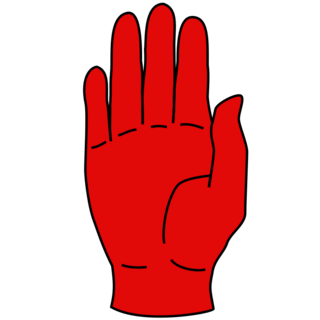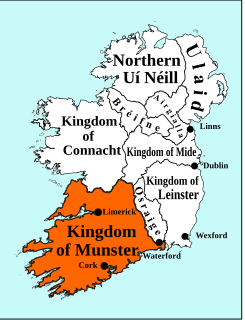There have been four Provinces of Ireland: Connacht (Connaught), Leinster, Munster, and Ulster. The Irish word for this territorial division, cúige, meaning "fifth part", suggests that there were once five, and at times Meath has been considered to be the fifth province; in the medieval period, however, there were often more than five. The number of provinces and their delimitation fluctuated until 1610, when they were permanently set by the English administration of James I. The provinces of Ireland no longer serve administrative or political purposes but function as historical and cultural entities.

In Irish origin myths, Míl Espáine or Míl Espáne is the mythical ancestor of the final inhabitants of Ireland, the "sons of Míl" or Milesians, who represent the vast majority of the Irish Gaels. His father was Bile, son of Breogan.

The Ulster Cycle, formerly known as the Red Branch Cycle, is a body of medieval Irish heroic legends and sagas of the Ulaid. It is set far in the past, in what is now eastern Ulster and northern Leinster, particularly counties Armagh, Down and Louth. It focuses on the mythical Ulster king Conchobar mac Nessa and his court at Emain Macha, the hero Cú Chulainn, and their conflict with the Connachta and queen Medb. The longest and most important tale is the epic Táin Bó Cúailnge. The Ulster Cycle is one of the four 'cycles' of Irish mythology and legend, along with the Mythological Cycle, the Fianna Cycle and the Kings' Cycle.

NiallNoígíallach, or Niall of the Nine Hostages, was a semi-mythical Irish king who was the ancestor of the Uí Néill or O'Cuinn dynasties that dominated the northern half of Ireland, reigning from the 6th to the 10th centuries. Irish annalistic and chronicle sources place his reign in the late 4th and early 5th centuries, although modern scholars, through critical study of the annals, date him about half a century later. He is presumed by some to have been a real person, or at the very least semi-historical but most of the information about him that has come down to us is regarded as legendary.
Túathal Techtmar, son of Fíachu Finnolach, was a High King of Ireland, according to medieval Irish legend and historical tradition. He is said to be the ancestor of the Uí Néill and Connachta dynasties through his grandson Conn of the Hundred Battles. The name may also have originally referred to an eponymous deity, possibly even a local version of the Gaulish Toutatis.
Mongfind —meaning "fair hair" or "white hair"—is a figure from Irish legend. She is said to have been the wife, of apparent Munster origins, of the legendary High King Eochaid Mugmedón and mother of his eldest three sons, Brión, Ailill and Fiachrae, ancestors of the historical Connachta. She was Eochaid's first wife; his second wife, Cairenn, gave birth to Niall of the Nine Hostages. Several tales depict Mongfind as an adversary of Niall. Mongfind is also said to have been the sister of Crimthann mac Fidaig, King of Munster and the next High King of Ireland, whom she is said to have killed with poison in a bid to make her son king. She drank the poisoned drink to convince Crimthann, and died soon after at Samhain.

The Iverni were a people of early Ireland first mentioned in Ptolemy's 2nd century Geography as living in the extreme south-west of the island. He also locates a "city" called Ivernis in their territory, and observes that this settlement has the same name as the island as a whole, Ivernia. It was probably once the name given to all the peoples of Ireland, but by Ptolemy's time had a more restricted usage applicable to the inhabitants of the south-west. These Iverni can be identified linguistically with the Érainn, a people attested in Munster and elsewhere in the early Middle Ages.

Crimthann Mór, son of Fidach, also written Crimthand Mór, was a semi-mythological king of Munster and High King of Ireland of the 4th century. He gained territory in Britain and Gaul, but died poisoned by his sister Mongfind. It is possible that he was also recognized as king of Scotland. This Crimthann is to be distinguished from two previous High Kings of Ireland of the same name, two Kings of Leinster, and another King of Munster, among others. Importantly, he is included in the Baile Chuinn Chétchathaig (summary), and is thus the last High King of Ireland from Munster until Brian Bóruma, over six hundred years later.

Meath was a kingdom in Ireland from the 1st to the 12th century AD. Its name means "middle," denoting its location in the middle of the island.
The term Kingship of Tara was a title of authority in ancient Ireland - the title is closely associated with the archaeological complex at the Hill of Tara. The position was considered to be of eminent authority in medieval Irish literature and Irish mythology, although national kingship was never a historical reality in early Ireland. The term also represented a prehistoric and mythical ideal of sacred kingship in Ireland. Holding the title King of Tara invested the incumbent with a powerful status. Many Irish High Kings were simultaneously Kings of Tara. The title emerged in the ninth and tenth centuries. In later times, actual claimants to this title used their position to promote themselves in status and fact to the High Kingship. Prior to this, various branches of the Uí Néill dynasty appear to have used it to denote overlordship of their kindred and realms. It was associated with Feis Temro, a pagan inauguration rite.

The Kingdom of Munster was a kingdom of Gaelic Ireland which existed in the south-west of the island from at least the 1st century BC until 1118. According to traditional Irish history found in the Annals of the Four Masters, the kingdom originated as the territory of the Clanna Dedad, an Érainn tribe of Irish Gaels. Some of the early kings were prominent in the Red Branch Cycle such as Cú Roí and Conaire Mór. For a few centuries they were competitors for the High Kingship or Ireland, but ultimately lost out to the Connachta, descendants of Conn Cétchathach. The kingdom had different borders and internal divisions at different times during its history.
Events from the 7th century in Ireland.

The Gaels are an ethnolinguistic group native to Ireland, Scotland and the Isle of Man in the British Isles. They are associated with the Gaelic languages: a branch of the Celtic languages comprising Irish, Manx and Scottish Gaelic.
The Darini (Δαρῖνοι) were a people of ancient Ireland mentioned in Ptolemy's 2nd century Geography as living in south Antrim and north Down. Their name implies descent from an ancestor called Dáire (*Dārios), as claimed by several historical peoples, including the Dál Riata and Dál Fiatach (Ulaidh) in the same area of eastern Ulster as well the Érainn (Iverni) of Munster. An early name for Dundrum, County Down, is recorded as Dún Droma Dáirine, and the name Dáirine was applied to the Érainn dynasty.
The Dáirine, later known dynastically as the Corcu Loígde and associated, were the proto-historical rulers of Munster before the rise of the Eóganachta in the 7th century AD. They were derived from or closely associated with the Darini of Ptolemy and were also related to the Ulaid and Dál Riata of Ulster and Scotland. Their ancestors appear frequently in the Ulster Cycle. In historical times the Dáirine were represented, as stated, by the Corcu Loígde, the Uí Fidgenti and Uí Liatháin, as well as a few other early historical kindreds of both Munster and Ulster. In ancient genealogical schemes, the historical Dál Fiatach of Ulaid also belong to the Dáirine.
The Mairtine were an important people of late prehistoric Munster, Ireland who by early historical times appear to have completely vanished from the Irish political landscape. They are notable for their former capital, Medón Mairtine, becoming the chief church of the later Eóganachta, namely Emly.







